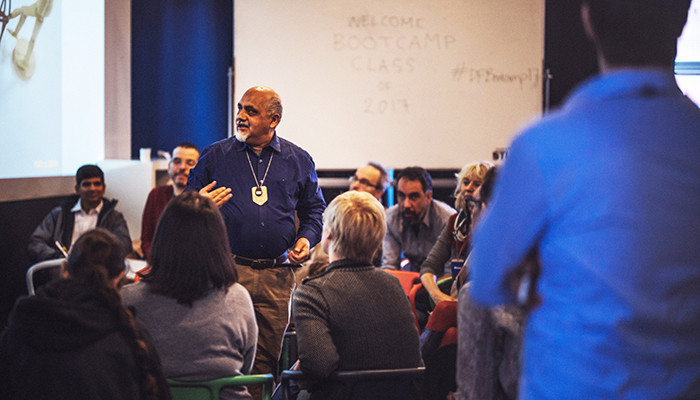Bootcamp takes Design Factory spirit to the world
Visitors from four continents came to Otaniemi to hear about problem-based learning and cross-disciplinary teamwork.

The week-long Bootcamp is a compact summary of what the Aalto-born Design Factory concept is about: problem-based learning, teamwork, and multidisciplinarity. This year, people from four different continents came to the training organised at Aalto University campus in Otaniemi.
Design Factory is an open-doors meeting place where ideas can take concrete shape. It is also a change agent for shaking up traditional learning methods and has a rapidly expanding international network.
‘Every year we get around 40 inquiries about how a foreign university can set up its own Design Factory. Bootcamp is the answer to those inquiries, it is a compact way of getting as much as possible out of the topic in the space of one week,’ explains Design Factory Global Network Strategist Päivi Oinonen.
Now being held for the fourth time, the Bootcamp gathered 26 participants from eight different countries. People had come along from a wide variety of contexts.
‘We have worked together with Pace University in New York for over five years already. Three new people came from there to get training in the Design Factory concept. The Indian Avantika University, on the other hand, will be just beginning operations in the autumn and is seeking from DF a model for constructing the whole university,’ Oinonen continues.
During the week there was brainstorming and training in areas such as planning workspaces which support making things by hand, pedagogy and forming a pro-innovation organisational culture. In addition, experiences were shared of Design Factory activities in places such as Melbourne in Australia, Porto in Portugal and Cern in Switzerland.

Project learning, workshops and cooperation with businesses are at the core of Design Factory’s activities, and this is same also for the Bootcamp. Photo: Aalto Design Factory
How do I find my way in the tower block?
Project learning, workshops and cooperation with businesses are at the core of Design Factory’s activities, and this is same also for the Bootcamp. Wednesday’s task was provided by lift company Kone. Groups comprised of Bootcamp participants, Design Factory students, business partners and TET interns had two hours to develop a guidance system for guiding people arriving at a high-rise building through the maze of lifts and corridors to their desired destination.
The buzz got going in the groups’ ‘activity bunkers’ and prototypes were built without fear of taking risks. Solutions included directions provided with lights, sound, or symbols as well as magic wristbands, robot dogs and talking cuddly toys.
‘In the workshop, things start to slot into place and the participants grasp the whole ‘students first’ operating principle,’ says Design Factory Bootcamp Coordinator Anniina Mansikka-Aho.
Compressing the dream into three minutes
‘The big message which we will be taking with us from Bootcamp is the importance of respecting pluralism. It is a fruitful foundation for developing new ideas,’ summarises Alexandre Martinazzo, a researcher and postgraduate student from Sao Paulo Polytechnic University.
Bootcamp has changed the whole way I think about teaching.
For Piotr Palka, a researcher and teacher at Warsaw University of Technology, the Design Factory is an ideal teaching space which is cooperative and unbounded.
‘Bootcamp has changed the whole way I think about teaching. It is a meaningful way to clarify one's thinking about a new teaching culture and plan one’s own Design Factory,’ Palka reports.
The week culminated with an open pitching event on Friday, where each person communicated in three minutes their thoughts and next steps for DF activities.
‘We have succeeded if participants leave here with the feeling that they have the ability, understanding and skills to go and effect change in their own university. Above all, what’s needed is the right people and the right environment,’ Mansikka-Aho concludes.


